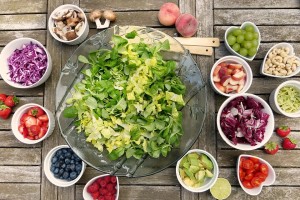An important part of a healthy diet is eating enough fiber. What is Fiber?
Fiber is the indigestible part of our food. It passes through our bodies without breaking down and being absorbed. There are two main types:
Insoluble fiber – This is the roughage or “tough” structural part of plants. Insoluble means that it cannot be dissolved in water. It acts as “bulk” to move along waste and material through our digestive system. Examples include vegetables such as cauliflower, celery, popcorn, nuts, apples and fruits with edible skins.
Soluble fiber – This type of fiber forms a gel-like material when dissolved in water. It helps you feel “full” and helps reduce blood sugar spikes. Soluble fiber binds with the water to soften waste and material, making it easier to eliminate. Soluble fiber is also necessary to bind hormones and cholesterol in the blood to detoxify and eliminate. Soluble fiber is found in flax, chia, psyllium, beans, citrus fruits, carrots, barley, oats and other grains.
We don’t digest fiber but it is a critical “nutrient” for our digestive tract and gut health. The health of our gut “microbiome” affects every system of our body, including our brains, nervous system, hormones and more. Hippocrates said “All States of Dis-ease begins in the Gut”.
Those experiencing constipation, irregular bowel movements, bloating or distention, gas or any other digestive upset may not be getting a proper amount of fiber.
Health Benefits of Fiber:
- Fiber fights Diseases. A diet high in fiber has been shown to prevent colon cancer and heart disease. It also lowers the chance of getting diabetes, insulin resistance, having high cholesterol. High fiber helps the body to eliminate cholesterol by binding it in the digestive tract. Adequate fiber intake helps to reduce the occurrence and severity of constipation.

- Fiber helps with Overeating & Cravings. All high fiber foods will take longer to chew and digest, making you feel satisfied longer. Soluble fiber expands in the digestive tract, increasing satiety and the feeling of fullness.
- Lose Weight with Fiber. Studies have shown that those who consume a fiber rich diet have better results in their weight loss efforts and keep it off. This is due to due to its filling effect and cravings, helping to reduce caloric intake and satiety, but also balanced blood sugars, healthy gut functioning, detoxification and balancing hormones to support weight loss.
- Fiber for a Healthy Microbiome. Fiber provides prebiotics, an important nutrient for our gut microbiome. Our gut contains billions of healthy bacteria known as probiotics. Prebiotics help nourish the probiotics, keeping our gut healthy and working optimally.
- Improved Digestion: Fiber is shown to reduce constipation, IBS symptoms and even hemorrhoids by supporting daily elimination and healthy bowel movements.
Where to Start:
- Vegetables are our top choices for fiber. Not only do they provide fiber, but they also contain phytonutrients, vitamins, minerals and anti-oxidants. Cruciferous veggies such as broccoli, cauliflower, brussel sprouts, kale, spinach and other dark leafy greens are some of the top choices. Remember to “eat the rainbow”; Consuming a variety of different colors, shapes and textures of produce will provide many nutrients but also keep meals interesting!

- Our other top favorite sources include: Psyllium husk, flaxseed, chia seeds, raw nuts and seeds, berries, apples, lentils, legumes, beans and all the vegetables listed above.
- While whole grains such as oats & breads contain fiber, they also can cause digestive upset. Gluten and grains are one of the top food sensitivities people have. Grains, specifically those gluten, can be inflammatory and do more harm than good for our health. If you choose to consume grains, be sure to choose a “sprouted” type and high quality non-GMO organic brands. Our top gluten free grains include quinoa and rice.
- Kids need fiber as well. Children that are older than 2 years of age should consume a daily intake of fiber. Kids are most receptive to fiber found in fruits and vegetables.
- More fiber requires more water. To keep fiber moving through your digestive tract, one needs to consume enough water. Everyone needs at least 1/2 of their body weight in ounces of water every day, and more if they’re active or exercise.
- Fiber cannot be cooked out. When you cook your fruits and vegetables, don’t worry about cooking the fiber out. The fiber found in fruits and vegetables aren’t just in the skin or in the peel. However, fiber is lost when juicing fruits and veggies and in dried fruits.
- More is not always better. You can in fact, get too much fiber. Consuming more than your body can handle can lead to diarrhea, bloating and other digestive upset. These symptoms are not healthy, as it can affect your body’s absorption of other key nutrients, vitamins and minerals. The recommended amount of fiber for adult women is 25-35 grams/day and men 30-40grams/day.
- Getting the right amount of fiber in your diet doesn’t have to be hard. It takes conscious effort to do include the right foods and you’ll be well on your way to a fiber rich lifestyle.
Some Fiber Rich Meal Ideas:
Breakfast:
Egg and veggie scramble
Protein shake with flaxseed and handful of spinach
Sprouted grain toast with avocado
Organic gluten free oats with berries
Lunch & Dinner:
Colorful Stir Fry: Chicken breast with asparagus, broccoli and peppers
Black Bean Burgers
Veggie rich Salad with dark leafy greens
Fish with Lentils or Brown rice
Snacks:
Raw almonds, walnuts and/or pumpkin seeds
Celery with almond butter
Carrots, cucumber and/or bell peppers with hummus
No-bake energy bites made with flaxseed, coconut flour & seeds
Chia seed pudding
As one of the key ingredients to healthy eating, fiber is something you don’t want to skip. Fiber can serve many different purposes, which were covered above. If you aren’t getting enough fiber in your diet – you should do something about now instead of waiting until you have symptoms or health concerns.
